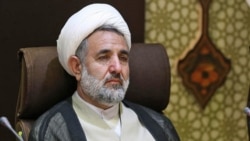An influential conservative lawmaker in Iran has tried to minimize the death toll of the protests that followed a gas price hike in November 2019.
Mojtaba Zolnur (Zonnouri), a member of the Iranian Parliament (Majles) from Qom told the semi-official Iranian Students News Agency (ISNA) on Monday June 1 that 230 people were killed during the protests in mid-November.
The figure is far less than reports and estimates by international news agencies, human rights organizations and the United States. In December, a special report by Reuters put the number of those killed during the violent crackdown at around 1500, and U.S. Special Representative for Iran, Brian Hook has said that around 1,000 protesters were killed by Iranian security forces during the unrest in November.
Zolnur, who was the chairman of the National Security and Foreign Policy Committee in the previous parliament, now is a candidate for the post in the new Majles that was opened on May 27.
He told reporters in Tehran that 6 of the 230 individuals killed in November were police officers, adding that 20 percent of those killed were volunteers working alongside the security and disciplinary forces. Zolnur must have been talking about the IRGC's Basij militia who played a major part in the violent crackdown against protesters.
Zolnur's claims puts the number of security elements among those killed in November at 52, leaving only 178 civilians among the dead.
According to Radio Farda's Iran analyst Reza Haqiqatnezhad, Zolnur claimed that "counter-revolutionaries" have said 10,000 protesters were killed during the crackdown. "That is a lie," says Haqiqatnezhad, "No one has said such a thing,” Zolnuri has simply tried to discredit the higher estimates."
Iranian journalist and analyst Behnam Gholipour tweeted that the Islamic Republic was waiting for an opportunity to finally announce its version of the November death toll and the protests in the United States afforded that opportunity.
Iran’s foreign ministry, government media and several politicians have reacted to the news of these protests, telling the U.S. to respect lives of its citizens and protect journalists. Opponents of the regime have reacted by saying that the Islamic Republic cannot whitewash its long history of suppression by hiding behind events in the United States.
Since November, the Islamic Republic has refused to release an official death toll and details about those killed during the protests. The same applies to those wounded or arrested.
Meanwhile, Zolnur claimed that 2,000 protesters and 5,000 security personnel were wounded during the mid-November unrest. However, Zolnur did not elaborate on the number of those arrested during the protests.
Earlier, a Radio Farda report said that at least 8,600 protesters were arrested in November. Iranian courts have issued death sentences to some of those who were arrested.
Zolnur who made too many claims during his interview with ISNA, also said that 22 percent of those who were killed had criminal records.
He added: "The death toll includes 7 percent who were killed during shootouts, 16 percent were shot to death during attacks on police stations, 26 percent were those who were killed for no particular reason and 31 percent were those who had attacked public places."
Interior Minister Abdolreza Rahmani Fazli also said on May 30 that some 200 to 225 individuals were killed during the November protests of which some 80 percent were shot to death with guns issued to Iranian security forces repeating the claim that some protesters have possibly killed others with other weapons.
In a report released last week, Amnesty International said that in all cases except four, protesters were shot to death by Iranian security forces including the IRGC, Basij militia and the police.
Amnesty International added that most of those who were killed were shot in the head or chest, which shows the security forces had a shoot-to-kill order.
The figures given away by Fazli and Zolnur are different from those announced by international organizations and human rights watchdogs.
Last week Amnesty International announced that at least 304 protesters were killed in 37 Iranian cities, stressing that these include only the cases that are accounted for and the actual number is probably much higher.
Meanwhile, last December, Reuters quoted three sources close to Khamenei's inner circle as well as another source as having said that some 1,500 Iranians were killed during the November protests. Khamenei had told the security forces in a public meeting: "Do whatever is necessary to stop" the protests.
The protests in November 2019 started after the government increased the price of gasoline by 200 percent without prior notice. When nationwide protests broke out, the government attempted to conceal the violent crackdown by imposing a news blackout and shutting down the Internet for several days.







